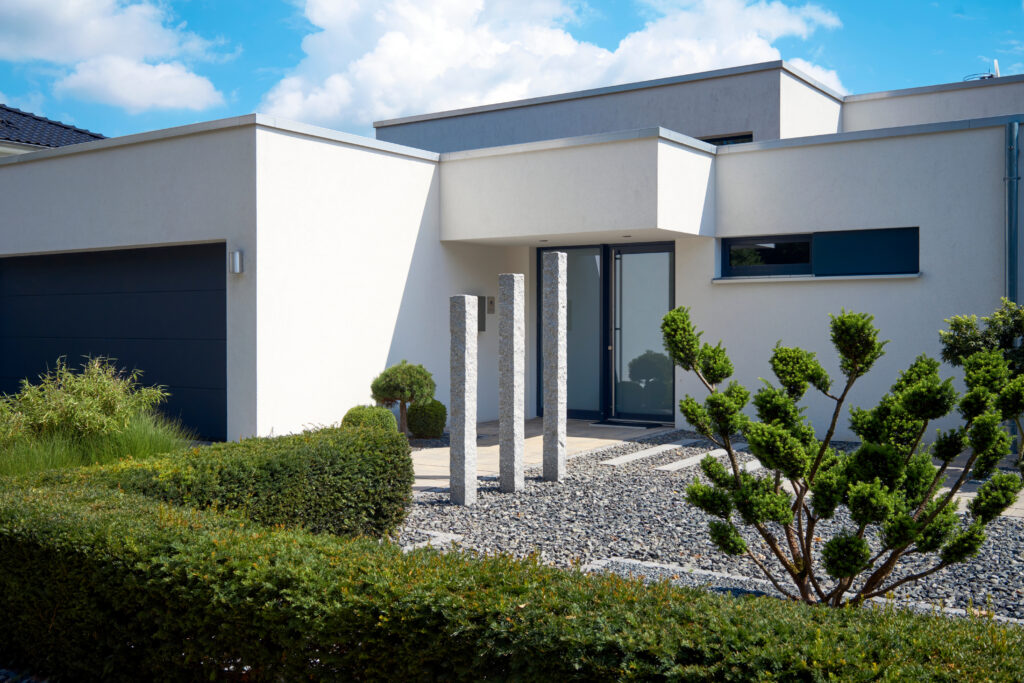All About Flat Roofing
Flat roofing types are as the name suggests: a roof surface that is flat, nearly level save for a slight slope for water drainage. They are most commonly used on commercial building, but are also used for homes that have a modern, contemporary aesthetic.
Flat roofs provide additional living space for home and green ares or HVAC units on commercial building. However, it is essential to have regular maintenance if your have a flat roof.

Types of Flat Roofs
Thermoplastic Olefin (TPO)
TPO is a popular option, especially in Central Texas. It is a reflective single-ply membrane. It offers energy efficiency and durability. It resists weather damage, including UV exposure and high winds.
Ethylene Propylene Diene Monomer (EPDM)
EPDM is made of a durable synthetic rubber that is energy efficient. It can withstand Texas’ extreme temperatures, UV exposure and high winds.
Polyvinyl Chloride (PVC)
PVC is a strong, heat-welded material. It is durable, environmentally friendly, fire resistant and energy efficient. It is commonly used across both residential and commercial roofs.
Modified Bitumen (Mod Bit)
Mod bit is an asphalt-based roofing material reinforced with polymers like fiberglass or polyester. It is flexible, energy-efficient, and highly durable. It can extreme temperatures, high winds, and heavy rains.
Built-Up Roofing (BUR)
BUR, or tar and gravel roofing, is a common option for commercial buildings. It combines felt and bitumen in layers, and usually topped gravel. It is durable and can withstand extreme temperatures, heavy rain, and UV exposure.
Ballast
Ballast roofing consists of a single layer waterproof member with a rock top roof. It is durable and can withstand high winds, hail, and UV exposure. In addition, it holds up well people walking on top of it.
How to know if a flat roof is right for you?
Budget
Flat roofs can be more affordable upfront but may require more frequent maintenance over time.
Climate
Withstands extreme temperatures and high winds. Requires proper drainage for areas with heavy precipitation.
Lifespan
On average, flat roofs last about 20 years. Materials, maintenance and weather conditions may affect lifespans of flat roofs.
Design
Flat roofs are ideal for additional outdoor space or solar panels. They are commonly used in commercial buildings.
Total Cost
The cost of flat roofs can vary depending on project size and materials used. Contact us for a quote.
What are the pros and cons of flat roofs?
Flat Roofing Advantages
Additional Space
Flat roofs can be used for rooftop gardens, green space, patios, solar panels, or HVAC units.
Accessibility
Because of the nature of flat roof structure and thus accessibility, they are simple for to access and repair.
Budget-Friendly
Flat roofs require less material and labor to construct. They provide a lower upfront cost – particularly for large-scale projects like commercial buildings.
Design Aesthetics
For residential roofing, flat roofs offer a contemporary design aesthetic.
Flat Roofing Disadvantages
Poor Drainage
Flat roofs are prone to water accumulation, which can lead to and leaks if not properly sloped.
Maintenance
Flat roofs require more maintenance than other roof types. Due to their lack of proper drainage, regular inspections and maintenance are essential to prevent water leaks and damage to the roof and underlying structure.
Less Energy Efficiency
While the materials used for flat roofs are often energy efficient, flat roofs can have poor insulation (unless it added) which can lead to increase energy costs for cooling and heating.
